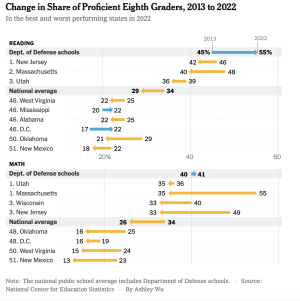
Who Runs the Best U.S. Schools? It May Be the Defense Department.
Schools for children of military members achieve results rarely seen in public education.
Who Runs the Best U.S. Schools? It May Be the Defense Department.
Schools for children of military members achieve results rarely seen in public education.Amy Dilmar, a middle-school principal in Georgia, is well aware of the many crises threatening American education. The lost learning that piled up during the coronavirus pandemic. The gaping inequalities by race and family income that have only gotten worse. A widening achievement gap between the highest- and lowest-performing students.
But she sees little of that at her school in Fort Moore, Ga.
The students who solve algebra equations and hone essays at Faith Middle School attend one of the highest-performing school systems in the country.
It is run not by a local school board or charter network, but by the Defense Department.
With about 66,000 students — more than the public school enrollment in Boston or Seattle — the Pentagon’s schools for children of military members and civilian employees quietly achieve results most educators can only dream of.
.............
Their schools had the highest outcomes in the country for Black and Hispanic students, whose eighth-grade reading scores outpaced national averages for white students.Eighth graders whose parents only graduated from high school — suggesting lower family incomes, on average — performed as well in reading as students nationally whose parents were college graduates.
The schools reopened relatively quickly during the pandemic, but last year’s results were no fluke.
While the achievement of U.S. students overall has stagnated over the last decade, the military’s schools have made gains on the national test since 2013. And even as the country’s lowest-performing students — in the bottom 25th percentile — have slipped further behind, the Defense Department’s lowest-performing students have improved in fourth-grade math and eighth-grade reading.
“If the Department of Defense schools were a state, we would all be traveling there to figure out what’s going on,” said Martin West, an education professor at Harvard who serves on the national exam’s governing board.
...............
But there are key differences.
For starters, families have access to housing and health care through the military, and at least one parent has a job.
“Having as many of those basic needs met does help set the scene for learning to occur,” said Jessica Thorne, the principal at E.A. White Elementary, a school of about 350 students.
Her teachers are also well paid, supported by a Pentagon budget that allocates $3 billion to its schools each year, far more than comparably sized school districts. While much of the money goes toward the complicated logistics of operating schools internationally, the Defense Department estimates that it spends about $25,000 per student, on par with the highest-spending stateslike New York, and far more than states like Arizona, where spending per student is about $10,000 a year.
“I doubled my income,” said Heather Ryan, a White Elementary teacher. Starting her career in Florida, she said she made $31,900; after transferring to the military, she earned $65,000. With more years of experience, she now pulls in $88,000.
Competitive salaries — scaled to education and experience levels — help retain teachers at a time when many are leaving the profession. At White Elementary, teachers typically have 10 to 15 years of experience, Ms. Thorne said.
Even small details matter. A well-stocked supply closet means teachers do not have to pay for paper, pencils and other necessities themselves.
In some public school jobs, as Jan Ramirez, a first-grade teacher, put it, “we were the supply closet.”
Prudence Carter, a Brown University sociologist who studies educational inequality, said the Defense Department’s results showed what could happen when all students were given the resources of a typical middle-class child: housing, health care, food, quality teachers.
...........
The Defense Department schools are hardly perfect. They also have some inherent advantages that other schools do not. More of their families have two married parents than is the case nationwide. By definition, at least one parent in each military family is employed. And the military provides health care and housing. |
“Having as many of those basic needs met does help set the scene for learning to occur,” Jessica Thorne, an elementary school principal at Fort Moore, said. |
Given this contrast, many other schools are unlikely ever to fare as well. Still, it would be a mistake to think that the military schools are thriving only because of the underlying differences in their students. After all, those differences have long existed — but the gaps between the Defense Department schools and all others have recently grown, especially among vulnerable students. |
Consider these two striking comparisons from Sarah’s story: At Defense Department schools, Black and Hispanic eighth graders have higher reading scores than white students do nationwide on average. And eighth graders whose parents graduated only from high school performed as well in reading as students nationwide whose parents were college graduates. |

